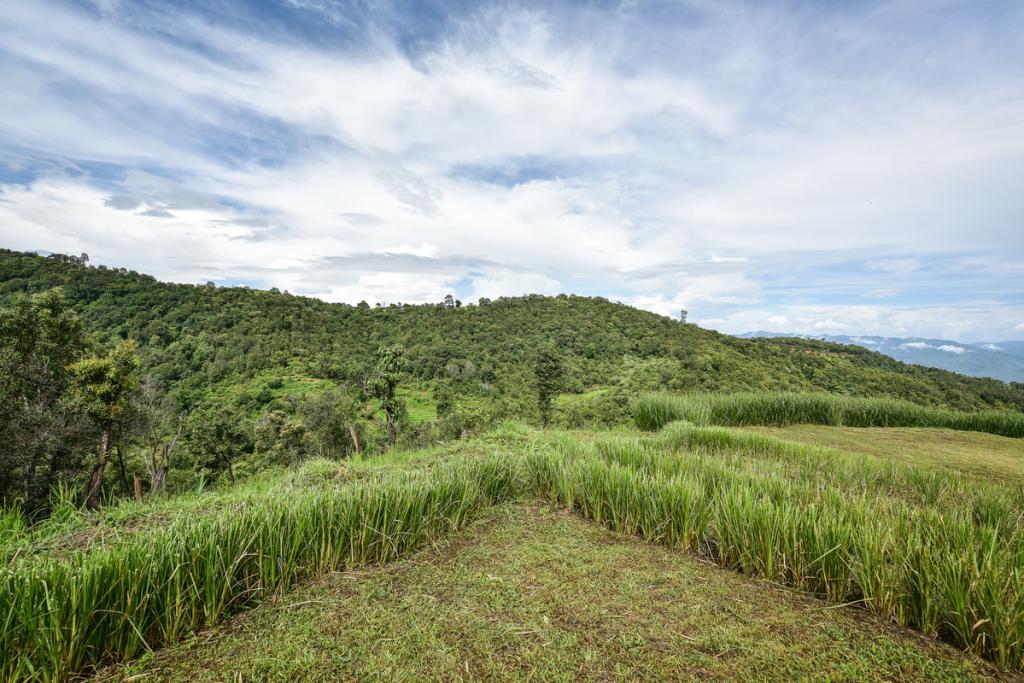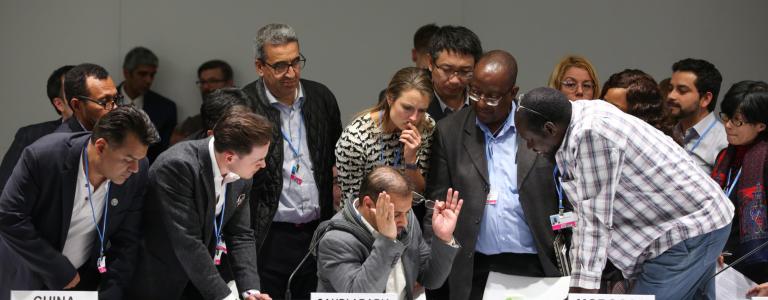The Triple-COP Year: What it means for nature
This is a significant year for the Rio Conventions on biodiversity, climate change, and desertification. For the first time since 2000, the Parties to the Conventions will have their negotiations in the same year. We take a look at the implications for nature.
Whereas global climate change Conferences of the Parties (COPs) and intersessionals occur on an annual basis, with expanding agendas and participant lists commanding global attention (UNFCCC COP 28 was attended by a record ~84,000 delegates), since 2000 these sister conventions have normally convened during alternating years. Due to delayed scheduling as a legacy of the global COVID pandemic, the parties to the three Rio Conventions will face a very busy 3 months, moving from Cali (Colombia) for biodiversity in October to Baku (Azerbaijan) for climate in November to Riyadh (Saudi Arabia) for desertification in December.
This triple-COP season is occurring against a backdrop of record-high temperatures in a year that has been punctuated by flash floods, drought, wildfires, and other extreme weather events around the globe, devastating communities, threatening biodiversity, and accelerating the degradation of soils. Parties will be tasked with agreeing on how countries should address these urgent threats. And there is increasing pressure to do so “synergistically” by targeting policies, programs, and initiatives to jointly address the goals of the Rio Conventions. This approach is expected to help stretch limited funds further, increase efficiency, and avoid duplicating efforts.
Cue nature. In recent years, the spotlight has turned to nature conservation and restoration as key to jointly addressing the goals of the Rio Conventions, the Sustainable Development Goals (SDGs), and other multilateral environmental agreements.

Achieving the Rio Conventions and SDGs through nature
There is global consensus over decades of research that nature—and nature-based solutions (NbS) or ecosystem-based approaches in particular—is central to the three Rio Conventions. With respect to the UNFCCC, nature restoration and conservation have proven to be key strategies for climate change adaptation and mitigation, with acknowledgements of trade-offs, limitations, and thresholds. The joint Intergovernmental Science-Policy Platform on Biodiversity and Ecosystem Services (IPBES) and Intergovernmental Panel on Climate Change (IPCC) workshop on biodiversity and climate change outlined the interconnections between biodiversity and climate, noting that NbS, such as sustainable agricultural and forestry practices, can improve adaptive capacity, enhance biodiversity, increase carbon storage, and reduce greenhouse gas emissions. The IPCC Special Report on Climate Change and Land also underscores that conserving and restoring nature contributes to combating desertification, with co-benefits for adaptation, mitigation, and sustainable development, as well as biodiversity. NbS can enhance soil fertility, increase carbon storage in soils and vegetation, and promote productivity. Examples include vegetated windbreaks and green walls planted with native vegetation to help shelter against dust and sandstorms.
The scientific and logical case for synergies based on nature have been established, yet NbS and ecosystem-based approaches still need to be strengthened in COP decisions and should play a more prominent role in national priorities and policies.
These national priorities include the key instruments of nationally determined contributions (NDCs) under the Paris Agreement, land degradation neutrality targets of the UN Convention to Combat Desertification (UNCCD), and National Biodiversity Strategies and Action Plans (NBSAPs) under the Convention on Biological Diversity (CBD).
Successes and sticking points on nature
In the UNFCCC sphere, NbS was recognized in the COP 27 cover decision, albeit in the context of forest ecosystems. Linkages between climate and nature were next referenced in COP 28 decisions, particularly as they relate to the first global stocktake, which referenced the Kunming–Montreal Global Biodiversity Framework (KMGBF). The COP 28 Joint Statement on Climate, Nature and People, which was issued by the three Rio Convention COP presidents along with signatory countries, commits signatories to coordinated action on voluntary partnerships, initiatives, and coalitions. The COP 28 decision on the Global Goal on Adaptation names ecosystems as a thematic target, with a call for reducing climate impacts on ecosystems and biodiversity and accelerating the use of ecosystem-based approaches and NbS.
Participants at UNCCD COPs have also referenced the critical role of nature in building resilience to floods and droughts, and particularly the role of NbS in protecting, restoring, and sustainably managing rivers and watersheds. The Abidjan Call, issued by Heads of State and Government at UNCCD COP 15, points to land and NbS as highly efficient, cost-effective, and nature-friendly approaches for a green recovery. The secretariat and parties have shown support for the UN Decade on Restoration, aiming to accelerate the restoration of 1 billion hectares of degraded land by 2030, with half of the global voluntary commitments for restoration being pledged under the UNCCD.

The NbS concept is closer to home in the CBD sphere, where related notions such as the ecosystem approach and ecosystem-based approaches have already been adopted by parties. Although the UN Environment Assembly adopted a multilaterally agreed-upon definition of NbS at its fifth session in 2022, NbS language is clearly a sore point for some parties to the CBD. The CBD COP 15 decision on biodiversity and climate change, a theme that has been addressed by every COP since 2004, was highly contentious, with parties unable to agree on a way forward. Parties considered draft text under this agenda item during the intersessional period leading up to CBD COP 16. However, the entire recommendation to the COP was “bracketed” owing to time constraints and is likely to be among the decisions parties will be working on during the final hours of the Cali conference. Among the points of contention, some parties and civil society actors are wary of the commodification of nature, the potential for violating human rights, and the consequences of sticking a label on or needlessly rebranding holistic practices that have a longer history, such as the ecosystem approach, ecosystem restoration, or ecosystem-based approaches.
After years of trying, NbS cannot seem to shake its reputation in some circles as being susceptible to greenwashing. Still, the hope is that parties can emphasize that, whatever it is called, NbS or ecosystem-based approaches must be rooted in human rights-based approaches with strong social and environmental safeguards.
Each successive climate, biodiversity, or desertification COP has a placeholder for decision text related to partnerships, collaboration, and fostering synergies among the Rio Conventions. But synergies are hard to realize in practice. In part, it is because each convention has evolved into an ever-larger ecosystem with a myriad of bodies and committees playing permanent catch-up with expanding workloads after each COP, making it difficult to see the big picture and work collaboratively across differing, and sometimes competing, national priorities. At the secretariat level, the Joint Liaison Group of the Rio Conventions was formed to share information and coordinate work across the conventions. It has previously highlighted nature, forests, and gender as key themes that promote synergies. However, changing leadership has sometimes resulted in differing priorities for cross-convention collaboration. More recently, the Rio Conventions Joint Capacity-building Programme was established to strengthen capacities at the institutional and policy levels to integrate and foster synergies between the Rio Conventions and the SDGs. Having three COPs uniquely lined up in one year should place renewed focus, increased resourcing, and ambition on partnerships and collaboration to enable coordinated policy development and implementation.
Elevating nature in the COP trifecta of negotiations
At the COP trifecta this year, parties should go beyond recognizing the role of nature in achieving the joint objectives of the Rio Conventions and elevate nature in their respective negotiations as a unifying theme to achieve progress on targets for climate, biodiversity, and land. Negotiators can be assured that their decisions are based on the international scientific consensus that biodiversity conservation and restoration are key actions to combat desertification, sequester greenhouse gases, and adapt to climate change.
What we need now is to mobilize resources for implementation, learn from successful examples of NbS/ecosystem-based approaches, and scale up investments in research and capacity.
In Cali, countries are considering how national targets and NBSAPs are aligned with the KMGBF. With the CBD COP underway, only 35 out of 196 parties have submitted updated NBSAPs that reflect the KMGBF. The KMGBF itself, including climate action-related Targets 8 and 11, must be supported by a robust monitoring and evaluation framework to track progress on NbS/ecosystem-based approach outcomes for biodiversity, people, climate change, and land degradation to quantify the degree to which NbS/ecosystem-based approaches are delivering multiple benefits.
In Baku, parties need to aim higher with the next round of NDCs, committing to scaling up and diversifying NbS or ecosystem-based approaches with concrete financing and implementation targets while also reducing greenhouse gases in accordance with the Paris Agreement goal of limiting global warming to 1.5°C. Going forward, successive climate COP presidents need to connect the threads on nature and biodiversity in their agendas and initiatives—for example, there should be a follow-up to the COP 28 Joint Statement on Climate, Nature and People, with renewed political commitment and increased support for partnerships and initiatives aimed at synergies and alignment on climate, biodiversity, and land.
In Riyadh, land degradation neutrality targets seeking to ensure no net loss of healthy land should be based on the hierarchy of avoiding land degradation in the first place, reducing it where possible, and restoring it where needed. Here, Parties need to emphasize and invest in NbS and ecosystem-based approaches that are centred on strong safeguards for nature and people, ensuring that quality and inclusive, human-rights-based approaches accompany the quantitative targets under the UN Decade on Restoration. Land degradation neutrality targets should be aligned with the current UNCCD Strategic Framework, the KMGBF, and the Paris Agreement. Concrete investments and partnerships should also be made for NbS and ecosystem-based approaches to increase the resilience of vulnerable populations and ecosystems to drought.
Whether it is called NbS, ecosystem-based approaches, or both, restoring, protecting, sustainably managing, and conserving nature through inclusive, rights-based approaches unite not just the Rio Conventions' targets but also other multilateral environmental agreement commitments (such as under the Ramsar Convention on Wetlands or the Convention on the Conservation of Migratory Species of Wild Animals) and the SDGs. Negotiators now need to ensure that initiatives carried out in the name of synergies are inclusive and rights-based, resilient to climate change, evidence-based, and built on values, trust, and integrity.
You might also be interested in
How to Make Nature-Based Solutions for Adaptation Work for Everyone
Effective nature-based solutions (NbS) for adaptation start with integrated climate risk assessments. These take-aways will help practitioners plan for inclusive and sustainable NbS.
Seeking Clarity on Nature-Based Climate Solutions for Adaptation
This guidance note clarifies the concepts behind nature-based solutions (NbS), nature-based climate solutions (NBCS), and ecosystem-based adaptation (EbA).
How Can We Work With Nature to Tackle Drought and Desertification?
Drought is one of the most devastating and pervasive challenges exacerbated by climate change. However, we can work to reduce its effects through nature-based solutions for land restoration and climate-smart agriculture.
For Nature-Based Solutions to Be Effective, We Need to Work with Indigenous Peoples and Local Communities
Nature-based solutions have been praised as a promising approach to tackling the twin crises of climate change and biodiversity loss. But some Indigenous Peoples and local communities are questioning the legitimacy of the concept and what it symbolizes. It is time to listen to what they have to say.
